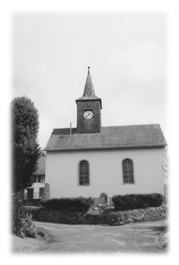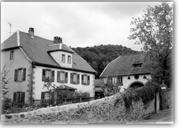John Frederick Oberlin was a Lutheran pastor and philanthropist in the Alsace region of eastern France. Six years after his death in 1826, his name re-emerged to identify the colony and college founded by John Jay Shipherd and Philo P. Stewart: Oberlin. A 1987 issue of The Oberlin Review ran a story about Erica Nelson's quest to find the gravesite of John Frederick Oberlin, a.k.a. "Papa Oberlin," as his burial plot indicates. I followed Erica's directions a few years later and found myself rediscovering a wonderful piece of Oberlin history.
 Visitors to the French cities of Strasbourg or Colmar in the Alsace region need to detour just a few hours to find Papa Oberlin's grave located in Fouday or his home in nearby Waldersbach. I recommend taking a detailed map such as Michelin #242; larger maps don't include these two towns. The area is quite beautiful, and adventuresome travelers should explore the underdeveloped country lanes that wind through the idyllic countryside and villages. On the map, these roads are depicted in white and yellow.
Visitors to the French cities of Strasbourg or Colmar in the Alsace region need to detour just a few hours to find Papa Oberlin's grave located in Fouday or his home in nearby Waldersbach. I recommend taking a detailed map such as Michelin #242; larger maps don't include these two towns. The area is quite beautiful, and adventuresome travelers should explore the underdeveloped country lanes that wind through the idyllic countryside and villages. On the map, these roads are depicted in white and yellow.
Upon reaching Fouday, a church steeple marks the cemetery: an old, small-town graveyard, well-kept and adorned with flowers. Unlike many of my cemetery searches, the plot was easy to find. A metal cross bearing Oberlin's nickname marks the grave, and the self-appointed town historian, Monsieur Hummel, is often on hand to greet tourists. He lives next to the church and once spent his days watching for visitors. He avoided speaking English with me, and prefers, I think, German or French.
During my brief tour of the cemetery, Hummel shared stories of Papa Oberlin's funeral in 1826 and the two-mile line of townspeople who came to pay their respects. As the head of the processional reached the cemetery, the last person in line stepped away from Oberlin's house and parish church located in the next town.
The church next to the graveyard was once part of John Oberlin's parish. It dates back to the 11th century, yet I was reminded of the later Quaker meeting houses in Pennsylvania. The interior is very plain; its wooden benches cover logs that feed the winter stove. An hourglass stands near the pulpit-the very one used by Papa Oberlin to time his Sunday morning sermons.
Papa Oberlin accepted the pastorship in Waldersbach in 1767 after studying theology at the University of Strasbourg. A supporter of Christian mysticism and the ideas of Rousseau, he was said to possess a rare spirituality combined with a talent for practical social development. The previous pastor had established a school and library, services Oberlin improved upon by further training the teachers and mandating that children attend school until the age of 16. He spent his long life in labor for the material and spiritual improvement of his impoverished parishioners, working to build roads and teach modern agricultural methods.
 Oberlin also developed the first of many "Oberlinvereince" orphan asylums for the protection of children. Doctors and medicine were rare, so he established a pharmacy in his home and arranged for new doctors to train and practice in his parish. He founded a loan and savings bank and introduced cotton manufacturing. And amidst all of these accomplishments, Oberlin is credited with spreading formal French throughout a region long isolated by its own difficult dialect.
Oberlin also developed the first of many "Oberlinvereince" orphan asylums for the protection of children. Doctors and medicine were rare, so he established a pharmacy in his home and arranged for new doctors to train and practice in his parish. He founded a loan and savings bank and introduced cotton manufacturing. And amidst all of these accomplishments, Oberlin is credited with spreading formal French throughout a region long isolated by its own difficult dialect.
Upon leaving the cemetery, visitors can take a two-mile drive to the preacher's home, Musée Oberlin, in Waldersbach. The museum devotes four rooms to the life of Oberlin, but visitors are often disappointed to find it closed. The Museum Alsatian in Strasbourg is also a stop for the Oberlin aficionado; a floor there is devoted to his life and impact on this area of France.
Ed. Note: A program of study abroad, the Oberlin Center of European Studies, was inaugurated during Oberlin's 1992-93 academic year in Strasbourg, France, the birthplace of John Frederick Oberlin. The program is designed to take advantage of Strasbourg's role at the heart of the newly emerging European Union.